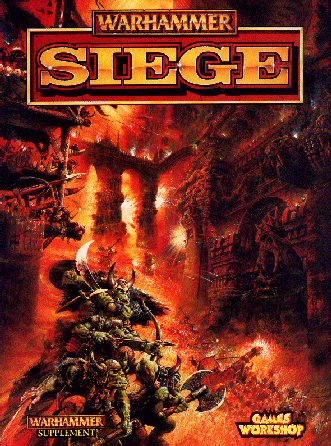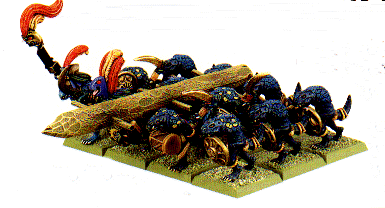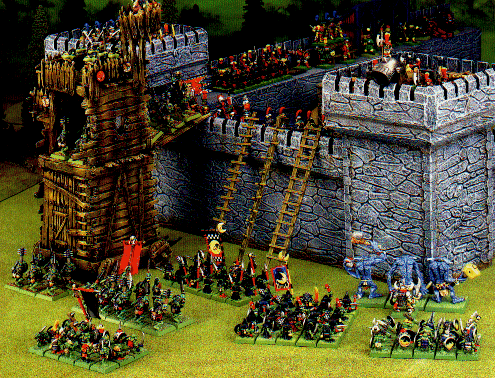Warhammer Siege
Written by Tuomas Pirinen with Nigel Stillman
Cover art by Geoff Taylor
Internal art by John Blanche, Alexander Boyd, Wayne England, David Gallagher, Mark Gibbons, Des Hanley, Toby Hynes, Nuala Kennedy, Paul Smith, Phil Stovin, John Wigley
Published by Games Workshop (£15) (88pp)
Reviewed by Robert Clark

Warhammer Siege was originally released as a supplement for 3rd edition WFB and WH40K in the late Ď80s, and as you might guess was concerned with playing Siege battles. This new edition handles WFB only, now re-written for 5th edition.
The first thing that hits you about this book is the excellent front cover by Geoff Taylor, which must rank among the best that he has done. I dare say that it is better than the Ian Miller cover for the original Siege, and sets the scene quite well. The internal artwork ranges from quality to lacklustre, and there is an unusually high number of old pieces from other books. A number of artists have worked on this book, though with the current GW trend of training all artists to draw in the same way, it is difficult to tell who drew what. Iím not the greatest fan of this style, and would prefer a greater range of styles employed. The layout of the book is GW standard, nothing to write home about and also the book is quite slender when compared to other recent £15 releases.
The actual rules themselves are considerably different from the original ones, slashing the complexity at a stroke. Some may consider this a good thing, but it does mean that Siege battles are no longer about an actual siege, more like a WFB battle with a castle getting in the way of the two combatants. As the rules are simplified, they are easy to pick up and get on with playing the game (assuming you have a castle of course), but Iím sure it would not have hurt to include advanced rules for weapons and the like. In the original Siege there was a great variety of weapons at the playerís disposal, including hat sand, lime, as well as boiling oil. Now we have boiling oil and thatís it. This is a shame.

In the original Siege there was greater emphasis on playing the game as a continued campaign centred on the siege itself, with the besieging player having to command his resources such as foraging or cutting wood for new artillery and the like, and the besieged player having to look after his dwindling supplies of food. Although most of the management of resources has gone, the writers have tried to compensate for this by including many of the potential situations that could have arisen as scenarios, which you can run in succession. The players get a number of actions that they can opt to do, such as repair fortifications, build siege equipment, send for help, etc. One problem I do have with this is the fact that you only get one attempt at storming the castle itself, which if you think about it is a little silly. In real life the attacking player would send occasional skirmishers to test the defences of different parts of the castle, and even if a major assault was a failure, they might try again once they have regrouped. Most of the scenarios donít even take place at the actual castle, usually at a Ďnearby bastioní which just happens to be in the way. As it stands you couldnít run a Siege game around one single fortification that you wanted to take without meddling with the scenarios, and the whole thing feels a little abstract. You donít feel as though your fortress is being slowly ruined from constant assaults, since its usually the little tower down the road that the savage hordes are storming.
As you might expect, there is a good part of the book devoted to the actual construction of a castle so you can play the game. With the plastic Citadel fortress costing as much as a small army, it is unlikely many will be willing to actually buy one, and so this section is definitely needed, but it still raises a question. Raising an army involved a lot of effort in choosing, buying and painting large numbers of troops, and to play Siege you will have to go to even more effort in building a castle, even before you can start to play! For the terminally unskilled and poor among us (including, sadly, the author of this review), Siege battles are a daunting experience, and no doubt many will fall by the wayside before such a project is complete. The actual instructions are fairly comprehensive for a bog-standard castle, and as long as you have an inkling of modelling talent and follow the instructions closely, you should be okay.

Finally we come to the tacked-on background section, which is brief to say the least. Each of the major races is looked at and their version of a castle described. This isnít just background, but is supposed to act as a guideline for building castles that donít follow the standard plan. Some of these are just silly, the Wood Elf tree fortress fitting this description rather well. Iím sure that they must cut down some wood, so why not actually build a proper fortress? Others are just as silly. This is an attempt to make the book appeal to generals of all races, but it just doesnít work.
In conclusion, there is a lot that could have been done with this book to make it better, but the crux of the problem is in its appeal. I get the feeling that siege battles will not appeal to many players, especially those who a) arenít made of money, b) use the model buildings supplied with the game because they are useless with a craft knife, and c) donít field a Human or Dwarven army. One good thing is that White Dwarf is promising to follow up with a number of ĎSiegeworksí articles that will provide new rules and ideas for Siege campaigns, though why they didnít just stick this in the book I do not know. A mixed bag, and certainly not something you can just pick up and play.
Robert
Homepage - Roleplaying - Wargaming - Rumour Control - SoapBox - Links - Banner page
Web Rings - E-mail - Submissions - Staff Writers - Tomb Raider - Fiction - Gamers Web Plus
British Dyslexia Association- Archive - News - Ask Auntie Cally- Retro